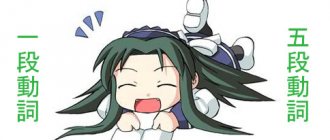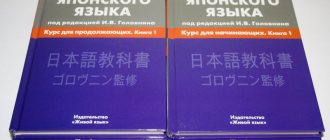Japanese grammar for beginners seems to be simple. Certainly many times easier than in Russian, English or German. There is no change in persons and numbers, and there is also no feminine or neuter gender. Unusually for us, difficulties with these basics arise only at first.
To fully understand oral speech, it is enough to remember about three hundred popular constructions. This is a clear indication of how basic Japanese grammar is.
The biggest difficulty you will face at first will be the unusual order of words in the sentence.
Sentence structure
The subject is always at the beginning of the sentence (precedes the predicate), and the predicate is always at the end (or before the respectful connective desu in formal style). Functional words are written after the significant word, and secondary members of the sentence are written before the main ones. The order of words always remains clear and unchanged.
Words, connectives and particles that are clear from the context are often omitted (both in oral and written speech). You can even omit the predicate or subject if this does not affect the overall meaning of the sentence.
Parts of speech
As in Russian, in Japanese words are divided into significant and auxiliary (non-significant).
The significant parts of speech include noun, verb, adjective, pronoun, numeral, adverb . They all have grammatical forms determined by their function in a sentence. Functional parts of speech include postpositions, conjunctions, particles, connectives . Interjections belong to a special group of words.
For your convenience, below Japanese grammar will be given in tables where possible.
Noun
Japanese nouns do not have the categories of gender and number . Nevertheless, it is still possible to show the number of nouns: for animate ones - by adding a suffix, for some animate and inanimate ones - by doubling the word itself.
Nouns change according to cases . eleven in total in the Japanese language . Case forms are formed by attaching a suffix to a noun, but only one case - the main case - has a suffixless form, so it is sometimes called suffixless.
| Case name | Suffix | What question does it answer? | Example |
| Basic (unsuffixed, sometimes thematic) | Does not require (sometimes は – wa) | Who? What? | 私は学生です。 Watashi wa gakusei desu. (As for me, then) I am a student. |
| Nominative (rhematic) | が(ga) | Who? What? | 私が学生です。 Watashi ga gakusei desu. The student is me. |
| Genitive | の (no) | Whose? Which? | 私の本 watashi no hon my book |
| Dative (location, direction, time) | に(ni) | To whom? Why? Where? When? | 友達に挙げる tomodachi ni ageru give to a friend 部屋にいる heya ni iru be (animate noun) in the room 学校に行く gakkou ni iku go to school |
| Accusative | を (wo) | Whom? What? | 本を読む hon wo yomu read a book |
| Creative (weapon of action or place of action) | で (de) | How? Where? | 箸で食べる hashi de taberu eating with chopsticks学校で学ぶ gakkou de manabu study at school |
| Directions | へ (he – read as [e]) | Where? To whom? | 公演へ行く kouen he iku go to the park |
| Joint | と (to) | With whom? With what? | 母と haha to with mom |
| Comparative | より(yori) | Compared to whom? Compared to what? | 本より hon yori compared to the book |
| Original | から (kara) | Where? From whom? | 学校から gakkou kara from school 母から haha kara from mom |
| Limit | まで (made) | To what place? To what extent? | 東京まで Tokyou made to Tokyo |
More information about cases in Japanese can be found here:
Adjective
three classes of adjectives in Japanese - predicative, semi-predicative and non-predicative.
Predicative adjectives
These include all adjectives ending in い(i). They have unchangeable stems ending in , , [u], [o]. Predicative adjectives form three main forms , which differ in the suffixes attached to the adjective stems.
| Form on い (i) | Shows present-future tense. It is used both as a predicate and as a definition. | 寒い samui cold赤い akai red小さい chiisai small | 天気は寒い。 Tenki wa samui. The weather is cold. 寒い天気 samui tenki cold weatherカキは赤い。 Kaki wa akai. Persimmon is red. 赤いカキ akai kaki red persimmon 目は小さい。 Me wa chiisai. The eyes are small.小さい目 chiisai me small eyes |
| Form in く (ku) (stem without い (i) + suffix く (ku)) | Used to form negative forms (stem + く (ku) + ない/なかった (nai/nakatta)) and other forms of adjectives. | さむく samukuあかく akakuちいさく chiisaku*よく yoku for 良い (ii/yoi) | 天気は寒くない Tenki wa samukunai. The weather is not cold. 寒くない天気samukunai tenki the weather is not cold. Kaki wa akakunai. Persimmon is not red. The eyes are rather big.小さくない目chiisakunai me rather big eyes |
| Form in けれ (kere) (stem without い (i) + suffix けれ (kere)) | Used to form conditional forms. | さむけれ samukereあかけれ akakereちいさけれ chiisakere*よけれ yokere for 良い (ii/yoi) | 寒ければsamukereba if cold赤ければakakereba if red小さければchiisakereba if small |
Semi-predicative adjectives
This class includes three types of words:
Semi-predicative adjectives can perform the same roles as predicative adjectives. However, semi-predicative adjectives always require a copula if they act as a predicate.
Semi-predicative adjectives have several forms:
| Form with な (na) | Used for adjectives in the attributive position. | 静かな shizukana quiet有名な yuumeina famous国際的な kokusaitekina international | 静かな部屋 shizukana heya quiet room有名な作家 yuumeina sakka famous writer国際的なフォーラム kokusatekina fo:ramu international forum |
| Form starting with に (ni) | The adjective acts as a circumstance. | 静かに shizukani quiet | 静かに泣く shizukani naku cry quietly |
| Base word with connective だ/です (da/desu) | An adjective is used as part of a predicate. | 静かだ shizuka da quiet有名だ yuumei da famous国際的だ kokusaiteki da international | 部屋は静かだ。 Heya wa shizuka da. The room is quiet.作家は有名だ。 Sakka wa yuumei da. The writer is famous. The forum is international. |
Non-predicative adjectives
They differ from adjectives of the other two classes in that they cannot act as a predicate and circumstance. That is, in a sentence they play only one role - the role of a definition to a noun . For example, 明くる日 (akuru hi) “next day”, あらゆる物 (arayuru mono) “all kinds of things”.
There are several more articles on Japanese adjectives on our website:
Verbs
Japanese verbs vary in stems, tenses, voices and moods. There are only two tenses in Japanese : present-future and past. Verbs can be transitive and intransitive, denote a continuous action or the result of an action, express an action or state.
In dictionaries, verbs are presented in dictionary form. It ends in [u] : う, く, ぐ, す, つ, ぬ, ぶ, む, る (u, ku, gu, su, tsu, nu, bu, mu, ru).
Japanese verbs vary in conjugation type. There are three in total:
| 1st conjugation | 2nd conjugation | Incorrect conjugation |
| All verbs whose dictionary form ends in う, く, ぐ, す, つ, ぬ, ぶ, む, る (u, ku, gu, su, tsu, nu, bu, mu, ru). And also exceptions to the 2nd conjugation. | Verbs ending in る (ru) but preceded by る (ru) are either [e], a separate letter or as part of a syllable. That is, verbs ending in “iru/eru” . There are exceptions! | The verbsする(suru) “to do” and来る(kuru) “to come.” |
Check out these articles about Japanese verbs:
Numerals
The Japanese language uses native Japanese numerals and Chinese numerals . There are only ten . But with the help of Chinese you can form numerals greater than 10 . Japanese ones are not used for this.
| Russian numerals | Japanese numerals | Chinese numerals |
| one | 一つ (hitotsu) | 一 (ichi) |
| two | 二つ (futatsu) | 二 (ni) |
| three | 三つ (mittsu/mitsu) | 三 (san) |
| four | 四つ (yottsu/yotsu) | 四 (shi, yon) |
| five | 五つ (itsutsu) | 五 (go) |
| six | 六つ (muttsu/mutsu) | 六 (roku) |
| seven | 七つ (nanatsu) | 七 (shichi, nana) |
| eight | 八つ (yattsu/yatsu) | 八 (hachi) |
| nine | 九つ (kokonotsu) | 九 (kyuu/ku) |
| ten | 十 (too) | 十 (juu) |
What are Japanese numerals used for?
In other cases, Chinese numerals are used. However, it should be noted that there are objects for which both Chinese and native Japanese numerals . Readings of Chinese numerals such as shi (4), shichi (7) and ku (9) are used less frequently than yon, nana and kyuu respectively.
Cardinal numbers in a sentence can have the following role: definition, nominal part of a compound nominal predicate, circumstance.
To get to know Japanese numerals better, you can look at these articles:
Adverbs
Adverbs in Japanese do not have any morphological features and, as in Russian, do not change. In addition, they are divided into categories: adverbs of place, adverbial adverbs, and so on.
In a Japanese sentence, adverbial and quantitative adverbs come before the verb or adjective, and adverbs of time come before the subject word.
We recommend this article about Japanese adverbs:
Pronouns
As in Russian, in Japanese pronouns are divided into categories : personal, demonstrative, interrogative, and so on. However, there are several nuances in their use.
Pronouns can often be omitted . The Japanese language is structured in such a way that it is clear from the context what your interlocutor or you yourself may be talking about. This is best seen in the personal pronoun “I”: you simply don’t have to pronounce it. A sentence without a subject often indicates that it is about the speaker himself.
Interrogative pronoun 何
The most necessary pronoun for beginners is the interrogative pronoun何 (nani, nan) “what?” . Used in questions about objects. Changes by case in the same way as a noun. In a sentence, the pronoun 何 can act as a subject, a modifier, an object, or a nominal part of a compound nominal predicate.
Personal pronouns
The use of personal pronouns in Japanese requires special care . If you use the wrong word, you can offend your interlocutor and appear rude. Pronouns are divided not only according to the degree of politeness, but also according to “male-female”. The table below shows only the official options, suitable for both boys and girls :
| 1st person | 2nd person | 3rd person |
| 私 watashi watakushi – more formal than watashi i | あなた anata you, you | あの方 anokata he (that gentleman/that lady) あの人 anohito he (that person) – less polite option |
Interrogative pronouns:誰 (dare), どなた (donata) – “who?” どなた (donata) is a more polite option.
Using the genitive case suffix の (no) you can form possessive pronouns : 私の (watashino) “my”, あなたの (anatano) “your”/“your”, あの方の (anokatano) “his”, あの人の ( anokhitono) "him".
In a sentence, personal pronouns can play the role of subject, attribute, object, or nominal part of a compound nominal predicate.
Structure of writing
The Japanese language is made up of a combination of three scripts. They are closely intertwined, so knowledge of each of them is necessary.
Hieroglyphs are not just a set of pictures. They obey certain laws and form into groups. Simple hieroglyphs are usually included in more complex ones. The meaning of a complex hieroglyph can sometimes be understood from the meaning of its simple components.
Since the characters (kanji) were adopted from the Chinese in the sixth century, the Japanese had to add endings, particles and conjugations to them to adapt them to Japanese accents, morphology and syntax. To write them, the Hiragana syllabary alphabet is used, in which all words of original Japanese origin are written. Hiragana can also be used to read characters, particles and endings (okurigana), and complex kanji. Japanese who study their native language in schools or on their own use hiragana for explanatory captions.
The katakana alphabet was created for writing borrowed words, terms, geographical and topographical names, nicknames, first and last names of foreigners. Less often, it performs a function similar to Russian italics.
In almost every sentence, Japanese grammar closely links all three types of writing.
A hieroglyph is an analogue of the root word in Russian. Hiragana in this case are prefixes, endings and various suffixes, and katakana are separately highlighted words of non-Japanese origin.
Studying grammar
Fact: Without knowing grammatical rules, learning Japanese is impossible. Without understanding the language structure, it will be difficult to understand how words and sentences are constructed in Japanese.
It may seem to a beginner that Japanese is a language where it is almost impossible to construct a whole sentence. Forget it. Despite the variety of sounds and syllables, constructing a speech in Japanese is not difficult.
- The subject is a part of speech that is not required for a sentence in Japanese. For the Japanese, the main meaning of a sentence is the predicate expressed by the verb. The action word must come at the end of the sentence.
- Gender does not apply to either nouns or verbs.
- Particles are another important component. Remember that the particle must match the word in front of it.
- Pronouns are used in dialogues or correspondence that require a formal tone. This part of speech is needed to indicate politeness.
Japanese grammar: features of tenses
In Japanese there are only past and present-future tenses. There is no form of future tense as such. To indicate actions or events that have not yet occurred, marker words are used: “in an hour,” “tomorrow afternoon,” “next month,” “a year later,” and so on. The sentence is written or spoken in the present tense. The use of marker words is mandatory, since their absence will make it difficult to understand the general meaning of what is being said.
Sentences that talk about future actions or events begin with an exact or approximate time (day, week, month, year) and end with a predicate in the present tense.
How does declension work in Japanese?
Various suffixes are added to the base of the word to give it the necessary grammatical meaning. Plus, when conjugating the base of a word, the sounds sometimes change.
All verbs and adjectives have two forms: final and non-final. The first is necessary in cases where you need to complete a sentence. The second is used to link several simple sentences into one complex one.
An important point: in Japanese, subjects must not agree with the predicate, and the modifier must not agree with the definition.
Finally, it should be noted that in Japanese there is a clear sequence of words in sentences. The subject group comes at the beginning, and the predicate closes the sentence.
Phonetics of the Japanese language
The entire phonetic paradigm is built on five vowels (a, i, y, e, o), which form syllables with consonants (k, s, t, n, m, p, x). There are only five syllable options in each row. The exception is the consonant “n”, as well as “o” in the accusative case, the syllables “va”, “ya”, “yu”, “yo”.
If you ignore the characters and focus solely on learning spoken language, Japanese grammar will seem very simple. There is no emphasis on tones and stress, as in Chinese, there are no sounds difficult to pronounce. It is much easier for Russian-speaking students to get used to the phonetic system of the Japanese language than for English-speaking ones. The latter often have problems articulating certain phrases.
Tutor or language school
When asked where to start learning Japanese from the very beginning, experts recommend using recorded Japanese audio lessons. There are quite a lot of them on the Internet, and everyone can choose the right option for themselves. This format will allow you to master the basics of Japanese, and then move on to a more complex level.
If you have more serious tasks ahead of you, for example, you are going to live or work in Japan, then you will not be able to avoid language courses.
You can enroll in a language school or take classes online. This format will not only allow you to learn useful phases, but will also teach you how to read and write in Japanese. With the help of qualified teachers, the language learning process will become correct, organic and effective.
The beginning of any lesson will be the study of the alphabet (katakana and hiragana). In two weeks you can master this material, knowledge of which will later allow you to write down phrases and sentences. This is an important stage, without which further work on learning the language is impossible.
Learning Kanji characters is much more difficult, but if you want to know the language perfectly, then it is worth your time. To learn Kandi, you should use flashcards designed for this purpose.










